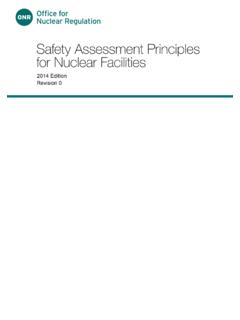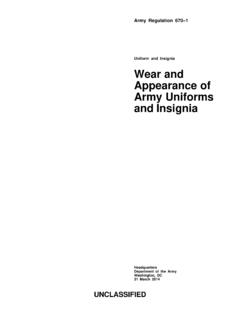Transcription of America’s Strategy to Secure the Supply Chain for a Robust ...
1 America's Strategy to Secure the Supply Chain for a Robust Clean Energy Transition Department of Energy Response to Executive Order 14017, America's Supply Chains . February 24, 2022. (This page intentionally left blank). ii AMERICA'S Strategy TO Secure THE Supply Chain FOR A Robust CLEAN ENERGY TRANSITION. ABOUT THE Supply Chain REVIEW FOR THE. ENERGY SECTOR INDUSTRIAL BASE. This document, America's Strategy to Secure the Supply Chain for a Robust Clean Energy Transition, lays out the challenges and opportunities faced by the United States in the energy Supply Chain as well as the Federal Government plans to address these challenges and opportunities. It is accompanied by several issue-specific deep dive assessments produced in response to Executive Order 14017, America's Supply Chains, which directs the Secretary of Energy to submit a report on Supply chains for the Energy Sector Industrial Base. The Executive Order is spurring the Federal Government to build more Secure and diverse Supply chains, including energy Supply chains.
2 To combat the climate crisis and avoid the most severe impacts of climate change, the United States is committed to achieving a 50- to 52-percent reduction from 2005 levels in economy-wide net greenhouse gas pollution by 2030, creating a carbon pollution-free power sector by 2035, and achieving net zero emissions economy-wide by no later than 2050. The Department of Energy (DOE) recognizes that a Secure , resilient Supply Chain will be critical in harnessing emissions outcomes and capturing the economic opportunity inherent in the energy sector transition. Potential vulnerabilities and risks to the Energy Sector Industrial Base must be addressed throughout every stage of this transition. This DOE energy Supply Chain Strategy report summarizes the key elements of the energy Supply Chain as well as the strategies the Government is starting to employ to address them. Additionally, it describes recommendations for congressional action.
3 DOE has identified technologies and crosscutting topics for analysis in the one-year time frame set by the Executive Order. Along with this policy Strategy report, DOE is releasing 11 deep dive assessment documents, corresponding to this report, covering the following technology sectors: carbon capture materials, electric grid including transformers and high voltage direct current (HVDC), energy storage, fuel cells and electrolyzers, hydropower including pumped storage hydropower (PSH), neodymium magnets, nuclear energy, platinum group metals and other catalysts, semiconductors, solar photovoltaics (PV), and wind. DOE is also releasing two deep dive assessments on the following crosscutting topics: commercialization and competitiveness, and cybersecurity and digital components. More information can be found at iii AMERICA'S Strategy TO Secure THE Supply Chain FOR A Robust CLEAN ENERGY TRANSITION. Acknowledgments The Department of Energy (DOE) acknowledges all stakeholders that contributed input used in the development of this report including but not limited to people representing a wide range of Federal agencies, state and local governments, industry, national labs, researchers, academia, and non-governmental organizations.
4 DOE is also grateful to the many people within various White House offices who contributed to this report. Additionally, DOE issued a request for information (RFI) to the public on energy sector Supply chains and received comments that were used to inform this report. In particular, from within DOE, acknowledgements go to: Principal Author Igogo, Tsisilile, Lead Supply Chain Coordinator, office of Policy [Detailee from the National Renewable Energy Laboratory]. DOE Contributors Basore, Paul, Chief Scientist, office of Energy Efficiency and Renewable Energy (EERE), Solar Energy Technologies office Bromhal, Grant, Acting Director, office of Fossil Energy and Carbon Management, Division of Minerals Sustainability Browne, Samuel, International Relations Specialist, office of International Affairs, office of International Market Development Caddy, Cherylene, Senior Advisor, office of Cybersecurity, Energy Security, and Emergency Response Coplon-Newfield, Gina, Chief of Staff, office of Policy Cunliff, Colin, Physical Scientist, office of Policy DeSomber, Kyle, Mechanical Engineer, EERE, Water Power Technologies office Diamond, David, Senior Analyst, EERE, Advanced Manufacturing office [Detailee from Geological Survey].
5 Frisch, Carla, Principal Deputy Director, office of Policy Gilman, Patrick, Supervisory Management and Program Analyst, EERE, Wind Energy Technology office Goff, Michael, Senior Advisor, office of nuclear Energy Hendrickson, Stephen, Energy Program Manager, office of Technology Transitions Hollett, Douglas, Advisor Critical Minerals and Materials, office of the Under Secretary for Science and Energy Melaina, Marc, Senior Analyst, EERE, Hydrogen and Fuel Cell Technologies office Papageorgopoulos, Dimitrios, Supervisory Scientist, EERE, Hydrogen and Fuel Cell Technologies office Pereira, Andre, Program Manager, office of Electricity Pielli, Katrina, Senior Policy Analyst, office of Policy Shrager, Benjamin, General Engineer, office of Electricity Simmons, Brad, Director, office of International Affairs, office of International Market Development Swanson, Frances, Special Assistant, office of Policy Veeder, Christy, Senior Advisor, office of Policy Winslow, Kyle, Legislative Affairs Lead, Loan Programs office Zevin, Avi, Deputy General Counsel for Energy Policy, office of the General Counsel DOE Reviewers Bauer, Diana, Acting Deputy Director, EERE, Advanced Manufacturing office iv AMERICA'S Strategy TO Secure THE Supply Chain FOR A Robust CLEAN ENERGY TRANSITION.
6 Capanna, Steve, Director of Technology Policy, office of Policy Chan, Vanessa, Chief Commercialization Officer & Director, office of Technology Transitions Golden, Robert, Special Advisor to the Chief of Staff, office of the Secretary Hoffman Patricia, Principal Deputy Assistant Secretary, office of Electricity Huff, Kathryn, Senior Advisor for nuclear Energy, office of the Secretary Jones-Albertus, Becca, Director, EERE, Solar Energy Technologies office Konieczny, Katherine, Assistant General Counsel for Energy Delivery and Resilience, office of the General Counsel Keavney, Dava, Senior Program Analyst, EERE, Advanced Manufacturing office Limmer, Rebecca, Supervisory Attorney-Advisor, Loan Programs office Mosley, Jennifer, Senior Communication Specialist, office of Policy Speakes-Backman, Kelly, Principal Deputy Assistant Secretary, office of Energy Efficiency and Renewable Energy Wagner, Jonah, Senior Advisor, Loan Programs office [Contractor].
7 V AMERICA'S Strategy TO Secure THE Supply Chain FOR A Robust CLEAN ENERGY TRANSITION. Nomenclature or List of Acronyms APP Affirmative Procurement Programs ATVM Advanced Technology Vehicles Manufacturing BIL Bipartisan Infrastructure Law, otherwise known as Infrastructure Investment & Jobs Act CCS Carbon Capture and Storage CISA Cybersecurity and Infrastructure Security Agency CO2 Carbon Dioxide DFC International Development Finance Corporation DHS Department of Homeland Security DOC Department of Commerce DOD Department of Defense DOE Department of Energy DOI Department of the Interior DOL Department of Labor DOS Department of State DRC Democratic Republic of the Congo ED Department of Education EERE DOE office of Energy Efficiency and Renewable Energy EIA Energy Information Agency EPA Environmental Protection Agency EOP Executive office of the President ERGI Energy Resource Governance Initiative ESIB Energy Sector Industrial Base EXIM Export-Import Bank of the United States FAR Federal Acquisition Regulation FECM DOE office of Fossil Energy and Carbon Management vi AMERICA'S Strategy TO Secure THE Supply Chain FOR A Robust CLEAN ENERGY TRANSITION.
8 FERC Federal Energy Regulatory Commission GHG Greenhouse Gases GW Gigawatt GWdc Gigawatt Direct Current HALEU High-Assay Low-Enriched Uranium HVDC High Voltage Direct Current ICT Information and Communications Technologies IEA International Energy Agency IIJA Infrastructure Investment and Jobs Act IT Information Technology ITC Investment Tax Credit LED Light-Emitting Diode LIB Lithium-Ion Batteries LPO Loan Programs office NASA National Aeronautics and Space Administration NDAA National Defense Authorization Act NDS National Defense Stockpile NIST National Institutes of Standards and Technology NRC nuclear Regulatory Commission NREL National Renewable Energy Laboratory NSF National Science Foundation NSTC National Science and Technology Council OMB office of Management and Budget OT Operational Technology PPA Power Purchase Agreements PSH Pumped Storage Hydropower PTC Production Tax Credit vii AMERICA'S Strategy TO Secure THE Supply Chain FOR A Robust CLEAN ENERGY TRANSITION.
9 PV Photovoltaics R&D Research and Development RD&D Research, Development, and Demonstration SBA Small Business Administration TPCC Trade Promotion Coordinating Committee TWh Terrawatt Hour USDA Department of Agriculture USTDA Trade and Development Agency viii AMERICA'S Strategy TO Secure THE Supply Chain FOR A Robust CLEAN ENERGY TRANSITION. Executive Summary The opportunity for global leadership on clean energy is enormous. On February 24, 2021, President Biden issued Executive Order 14017, America's Supply Chains, directing the Secretary of Energy to submit a Supply Chain Strategy overview report for the Energy Sector Industrial Base (ESIB). This report lays out the myriad challenges and opportunities facing the energy Supply Chain along with key strategies to Secure America's position as a clean energy superpower in the years and decades to come. The challenges are immense for the United States related to: raw material availability; manufacturing capacity.
10 Dependence on foreign supplies; worker training; global trade practices; cybersecurity; and research and data analysis needed to create the clean energy economy we need. But the opportunities to address the energy Supply Chain are also immense for the American people: millions of family-sustaining clean energy jobs spread throughout the country; world-class training and research; access to clean and lower-cost energy for all Americans, including those who have been historically left behind; a more resilient American economy for the long term; and an energy system that protects our climate. The climate crisis poses an existential crisis to American and global national security and economic interests. It also presents a tremendous opportunity for American innovation, allowing for a reinvestment in the American manufacturing base and for the widescale creation of high-quality jobs in the clean energy economy. The United States has committed to an ambitious and achievable goal to reduce net greenhouse gas (GHG) emissions 50 to 52 percent below 2005 levels by 2030, create a carbon pollution-free power sector by 2035, Strategic Opportunities and achieve net zero emissions economy- wide by no later than 2050.














